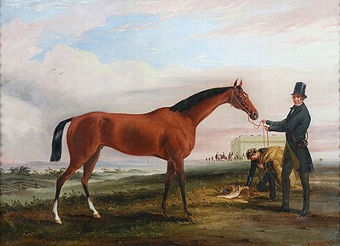Charles Robert Leslie''s portrait of Reynolds is proof of the high regard he had for Reynolds. Leslie was one of the new students at the Royal Academy and he would have without doubt seen Reynolds self portrait at the Royal Academy.
Reynolds Painted his self portrait in Circa 1780. This portrait and Reynolds''s portrait of William Chambers hung at either side of the chimney in the Royal Academy Assembly Room, Somerset House, the institution that he had helped to found and of which he was the first president. Reynolds wears the robes of a Doctor of Civil Law, a degree conferred upon him by the University of Oxford in 1773. Reynolds pays tribute to his hero Michelangelo, by including a bust of this artist. His debt to Rembrandt is also apparent in the composition and his use of light and shade.
No false modesty there, then - and no nonsense either about psychological insight or self-revelation. Reynolds shows himself exactly as he wished the world to see him, a pillar of the establishment dressed in the velvet cap and crimson robes he had worn when Oxford University conferred on him an honorary degree in 1773. He then indicates his professional status by the presence of a bust of Michelangelo at his side, and, more subtly, by constructing a composition that recalls Rembrandt''s famous Aristotle Contemplating a Bust of Homer.
Charles Robert Leslie (1794-1859), English genre painter, was born in London on 19 October 1794. His parents were American, and when he was five years of age he returned with them to their native country. They settled in Philadelphia, where their son was educated and afterwards apprenticed to a bookseller. He was, however, mainly interested in painting and the drama, and when George Frederick Cooke visited the city he executed a portrait of the actor from recollection of him on the stage, which was considered a work of such promise that a fund was raised to enable the young artist to study in Europe.
He left for London in 1811, bearing introductions which procured for him the friendship of West, Beechey, Allston, Coleridge and Washington Irving, and was admitted as a student of the Royal Academy, where he carried off two silver medals. At first, influenced by West and Fuseli, he essayed high art, and his earliest important subject depicted Saul and the Witch of Endor; but he soon discovered his true aptitude and became a painter of cabinet-pictures, dealing, not like those of Wilkie, with the contemporary life that surrounded him, but with scenes from the great masters of fiction, from Shakespeare and Cervantes, Addison and Moliere, Swift, Sterne, Fielding and Smollett.
Of individual paintings we may specify Sir Roger de Coverley going to Church (1819); May-day in the Time of Queen Elizabeth (1821); Sancho Panza and the Duchess (1824); Uncle Toby and the Widow Wadman (1831); La Malade Imaginaire, act iii. sc. 6 (1843); and the Dukes Chaplain Enraged leaving the Table, from Don Quixote (1849). Many of his more important subjects exist in varying replicas. He possessed a sympathetic imagination, which enabled him to enter freely into the spirit of the author whom he illustrated, a delicate perception for female beauty, an unfailing eye for character and its outward manifestation in face and figure, and a genial and sunny sense of humour, guided by an instinctive refinement which prevented it from overstepping the bounds of good taste.
In 1821 Leslie was elected A.R.A., and five years later full academician.
In 1833 he left for America to become teacher of drawing in the military academy at West Point, but the post proved an irksome one, and in some six months he returned to England. He died on the 5th of May 1859.
In addition to his skill as an artist, Leslie was a ready and pleasant writer. His Life of his friend Constable, the landscape painter, appeared in 1843, and his Handbook for Young Painters, a volume embodying the substance of his lectures as professor of painting to the Royal Academy, in 1855. In 1860 Tom Taylor edited his Autobiography and Letters, which contain interesting reminiscences of his distinguished friends and contemporaries.
Antiques.co.uk Ref: UE25RKXU
- Materials:
- Oil on Panel
- Width (cm):
- 26.92 x 21.84cm (10.60 x 8.60ins)














